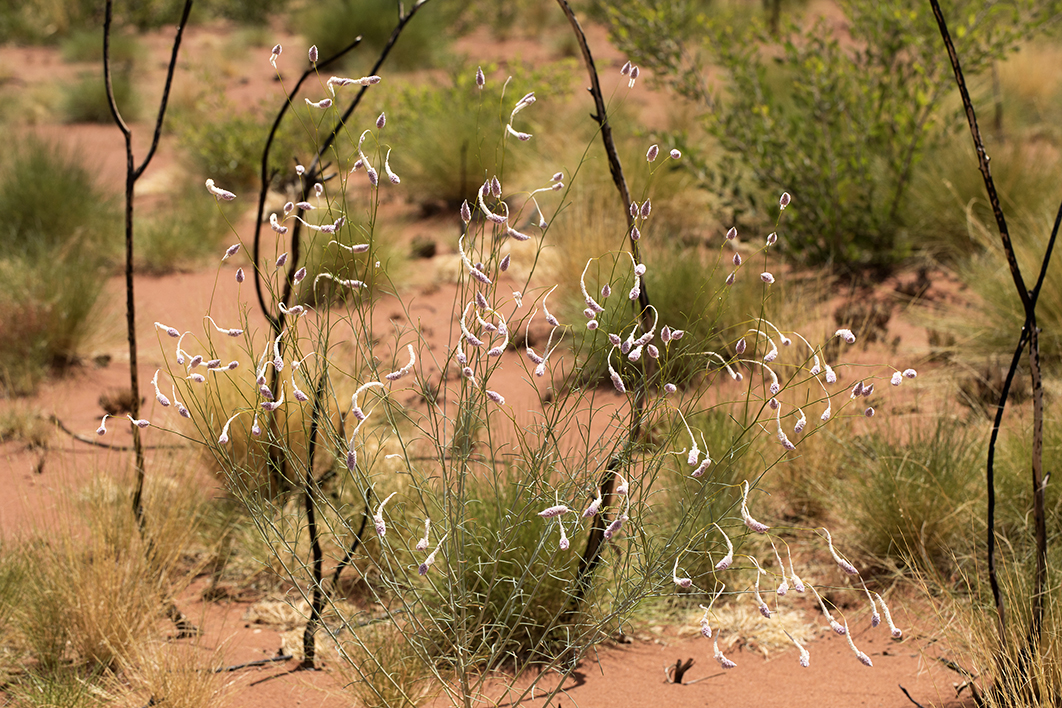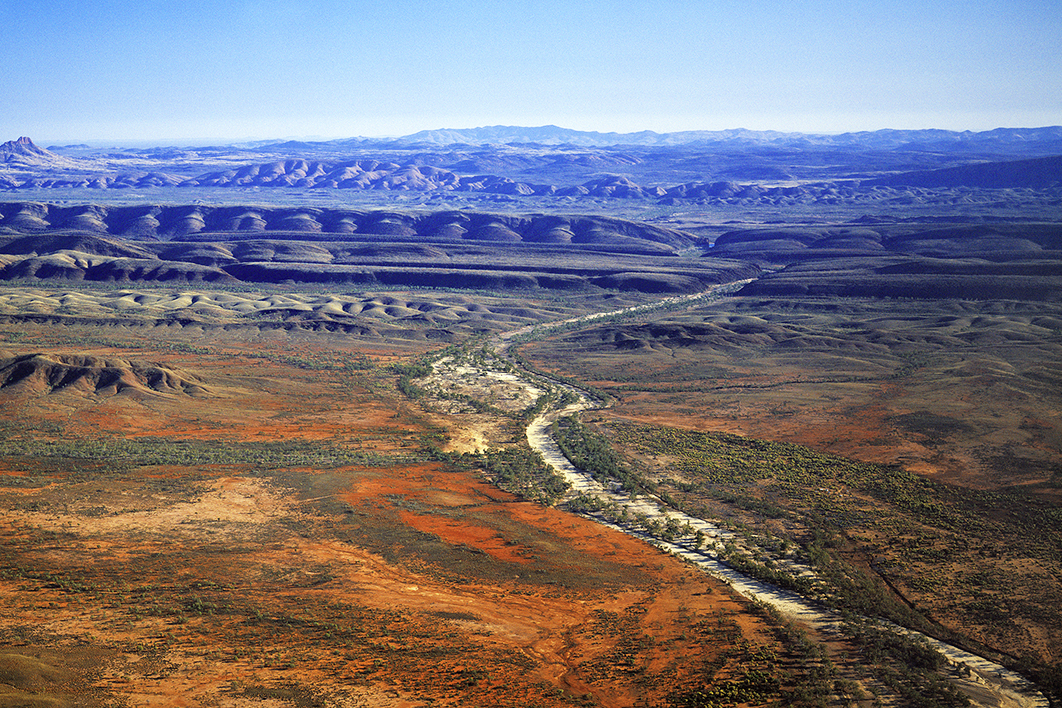How does life, in all its myriad forms, find ways to thrive and survive in an environment of extremes? It is a question that takes us not only to the core of our continent but also to the heart of our identity as Australians.
How do plants, animals, insects, birds, nesting bees, raspy crickets, humans, mulgaras, yellow billy buttons, bats, bush flies, river red gums, euros, desert oaks, salt lake wolf spiders, thorny devils, copperburrs, mulga, sap suckers, zebra finches, waddywoods, banded stilts, spinifex, marsupial moles, antlions, Mitchell grass, lerps, harvester termites, burrowing frogs and fat-tailed dunnarts — how does this gorgeous, ebullient array of life come to be, how does it find ways to flourish, and how do its constituents relate to one another, now and over time, across millions of years?
How do we learn to see the richness and diversity of this life? How do we read Country for its presences and absences? How do we fine-tune our capacity as humans to appreciate and understand the miracles that unfold at our feet and under the skies every day and night? These are beautiful, inspiring, exhilarating questions and they underpin this book, which is a glowing compendium of intelligent wonder.
Steve Morton is our guide in this quest, an admired CSIRO scientist, a renowned ecologist and a gifted writer, and he is introducing us to his home, the beautiful and diverse arid lands of Australia. Australian Deserts: Ecology and Landscapes is about two-thirds of the continent, an astonishing and vast region, and everything that lives in it.
And we glimpse our guide too from time to time: a human in his chosen and beloved setting, relishing a desert dawn, attending a pit-trap, sharing a cup of campfire tea with colleagues, or driving at dusk on the saltbush plains, his forearm resting on the open window when a raspy cricket, large, slim and stylish in tawny colours, lands on his arm. Steve and the handsome insect exchange a glance before the cricket sinks its jaws painfully into his skin. As he fights the pain and fights to keep the car on the road, Steve can’t help admiring the poise, attitude and éclat of that rascally raspy.
Admiration is a strong emotion in this book. This is science with a heart. The natural world elicits Morton’s appreciation and awe. And he accommodates mystery. He is often happily astonished: when describing masses of grasshoppers shooting up into the jet stream and flying halfway across the continent, he exclaims, “who would have believed such a thing?” It’s “a life history,” he says, “that seems like science fiction.”
There is tenderness, too, in the author’s relationship with other forms of life, a warm regard for his fellow creatures and the miracles of survival they daily perform. He describes desert ecologies with rapt affection and pries into the personal lives of plants and animals with delicacy and respect. He is careful not to be sentimental or anthropomorphic, but he does use his imagination and literary skills to project the reader into the experience of other living things: we are offered X-ray vision so that we can see inside river red gums, underground radar so that we realise how much life is busy beneath us, and time-lapse imagery so that we can appreciate the workings of evolution. We are even enabled to sit between the wings of a grey teal in flight.

Weeping mulla mulla growing among feathertop spinifex and shrubs regenerating after fire in the Tanami Desert. Mike Gillam
There is a kind of autobiography of a desert ecologist that can be gleaned from the pages of this book. We see the author in his late teens out with his dad admiring merino sheep and talking to a farmer on the Hay Plain. The youth is distracted from pastoral talk by male brown songlarks in a frenzy of breeding display; he becomes captivated by their soaring and plummeting, by their singing at full throttle to the female birds.
Young Steve hears their call, too, and soon he is lured away from his destiny as a farmer. And later at university we see him having a Eureka! moment in his first-year biology practical class when he peers into a microscope at the profuse life to be found in the abdomen of a termite. He shouts with glee at the sight of such a vigorous diversity of organisms. In that moment, he decides to become a biologist, and he has felt grateful to termites ever since.
Although Steve Morton is a particularly fine individual of the human species, this book is not about him. His modest appearances on the surface of the text are as fleeting as those of the burrowing frog after rain. But the warmth of his curiosity and the joy of his wonder suffuse the book.
He is not the only human who appears in this text. There is a strong sense of an intellectual community, of the collegiality of ecologists and bush scholars; there is an international fellowship of the field and the laboratory, of the lecture hall and the tea room. Every insight depends on others; knowledge is collective and organic. It advances by being shared and tested; it relies upon teamwork, upon long-term observation in the field, upon a robust scientific culture. This book glows with pride at the collective achievement of ecologists in Australia over decades.
And it glows too with respect for the knowledge and teaching of Aboriginal peoples. It is wonderful to read an ecology of Australia that is so plainly and profoundly indebted to the ecological wisdom of First Nations peoples. Here is the kind of respectful confluence of traditions of knowledge that so many people have been striving for, especially in Alice Springs.
It’s not just about supplementing Western science with Aboriginal insights; rather, it’s about recognising — as this book does — the primacy of Aboriginal understanding and management of Country and making that deep knowledge the foundation for all ecological inquiry. The result is immensely heartening and quite beautiful, a respectful integration of Aboriginal and settler philosophies, united in their awe of the land, nature and the elements.
There are three further ways in which this book might be honoured in the traditions of science and literature. First, it enacts an ecological vision. As I read this book, I truly begin to understand what it is like to think and see like an ecologist. So Australian Deserts is not just about a vast, enchanting region, it is also about a particular way of seeing the world in all its vibrant connectedness. Science leads to philosophy which leads to poetry, and insights flow the other way too, from art to ecology. From now on, if people ask me what an ecological vision means, I will give them this book.
Second, Australian Deserts is a remarkable contribution to two centuries of Australian desert literature. Here I can only briefly invoke an impressive lineage of which Morton is very conscious: writings by Ernest Giles, Baldwin Spencer and Frank Gillen, Cecil Madigan, Ernestine Hill, Hedley Finlayson, Alice Duncan-Kemp, Francis Ratcliffe, Ted Strehlow, Alan Newsome, Isabel McBryde, Dick Kimber, Peter Latz, Kieran Finnane, Tim Rowse, Mike Smith, Barry Hill, Eleanor Hogan, Mark McKenna, Margaret Kemarre Turner, Rod Moss and Kim Mahood, to name just a few. This constant pulse of scholarly and literary reflection coming from the heart of Australia has changed national understandings and identity, and Morton’s book embraces that conversation and adds to its richness.
Much of the early desert literature was about searching and disappointment, about expectation and failed dreams, but Morton writes as someone who is joyously, ecstatically at home, intellectually and emotionally fulfilled by the ecology and landscapes of arid Australia. And Aboriginal peoples appear not as strange or other but as respected teachers, their ancient and continuing cultures the embodiment of what it means to read and love Country.
Third, Australian Deserts, although primarily a scientific work, is also a book-length piece of nature writing. Morton is an exquisite writer. Part of the pleasure of reading this book is the sheer elegance and precision of every sentence. There is a formal grace to his prose, a quiet majesty to the intricate portrait he weaves. Literary exactitude is, in his hands, a scientific instrument, an essential tool in his quest to create holistic understanding.
Morton is educating us in a more precise language about deserts, and tutoring us in a different sense of time, not just of deep time but of slow time. For desert life is patient and so must we be. The author reminds us that at times of climatic stress, “the country is waiting rather than dying.” Without us being told explicitly, we come to understand that an ecologically intact landscape tends to be beautiful.
Thus, I would place Australian Deserts in another lineage, an international bookshelf of nature writing where science and literature coalesce felicitously. On that shelf can be found Aldo Leopold’s A Sand County Almanac, Rachel Carson’s Silent Spring, Annie Dillard’s Pilgrim at Tinker Creek, Richard Nelson’s The Island Within, J.A. Baker’s The Peregrine, Nan Shepherd’s The Living Mountain, George Seddon’s Landprints, and Barbara York Main’s study of the Western Australian wheatbelt, Between Wodjil and Tor.
Australian Deserts is destined to become a classic for this combination of scientific vision and literary poise, and because there is a further dimension of magic in it. Mike Gillam’s photographs of desert life and landscapes are, quite simply, extraordinary. They are no mere illustrations of the text, although they do perform that role superbly. They offer a parallel vision that complements the micro and macro scales of the prose. The book is subtitled Ecology and Landscapes, for “ecology” invokes science and “landscapes” invokes art. But “ecology” also suggests intricacy and “landscapes” implies vastness. Mike Gillam’s photography works on both levels; indeed, it is one of his conjuring tricks to make an aerial landscape photo look like a view through a magnifying glass and a close-up ground portrait look like a view from the air. There is a powerful ecological message in that, about systems and patterns across all scales of a landscape.
Gillam’s pictures are painterly photographs, high-art in the poetics of colour and light, yet they are also scientifically precise and stunningly intimate. They bring you eye to eye with insects and animals; Mike must have learned the patience of the deserts to capture such portraits. Such are the fruits of obsession. Mike Gillam on Australian deserts deserves the recognition accorded to Olegas Truchanas and Peter Dombrovskis on Tasmania’s Southwest.
This is a book that will bring learning, joy and inspiration to generations of humans, and greater compassion for our fellow creatures. It may also help us to live here with deeper respect and understanding, and with a keener awareness of beauty, wonder and complexity in this magnificent land. •
Australian Deserts: Ecology and Landscapes
By Steve Morton, with photographs by Mike Gillam | CSIRO Publishing | $59.99 | 304 pages




